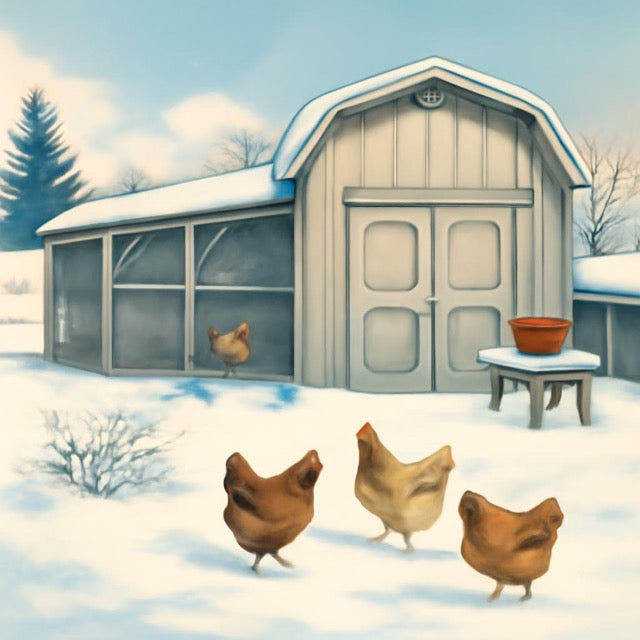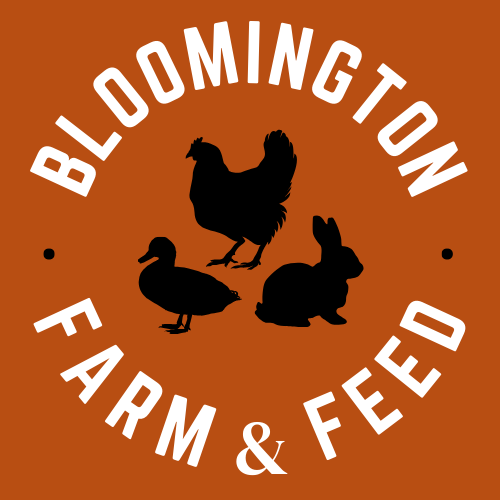
Winterizing Your Poultry Coop: Essential Tips for Urban Chicken Owners in Northern Climates
Michelle ZimmerShare
As winter approaches in Bloomington, MN, it’s time to ensure that your feathered friends are cozy and protected from the harsh elements. With temperatures sometimes plummeting to -25°F, it's crucial to winterize your poultry coop effectively. Here are some practical tips tailored for urban chicken owners with 2 to 20 birds, focusing on how to keep your chickens comfortable and healthy during the cold months.
1. Wrap Your Covered Run
One of the best ways to protect your chickens from wind, snow, and rain is by wrapping your covered run with poly film plastic. This transparent plastic will create a barrier that shields your chickens from the elements while allowing sunlight to filter through, keeping their environment bright and inviting.
Steps to Wrap Your Run:
- Measure the Area: Start by measuring the dimensions of your covered run to determine how much poly film you will need.
- Choose the Right Material: Select a durable, UV-resistant poly film that can withstand the winter elements. We recommend this film.
- Secure the Film: Place the plastic film over a wood post on one end of the run, and use duct tape to secure it in place. By putting a strip of duct tape over the plastic that's overlaying that wood beam, you can then use a staple gun to attach the film to the wood frame of the run, ensuring it is tightly secured to prevent any drafts. Believe it or not but, by stapling through the tape plus plastic, to secure it to the wood beam, it creates a stronger attachment to the run, which will withstand any high winds that come up during storms.
- Leave Openings: Consider leaving openings for ventilation at the top, as proper airflow is essential to prevent moisture buildup that can lead to respiratory issues.
2. Heated Water Containers
Water is vital for your chickens, especially in winter when they are at risk of dehydration due to freezing temperatures. Invest in heated water containers that keep the water from freezing, ensuring your chickens always have access to fresh, drinkable water.
Tips for Heated Watering:
- Choose Quality Products: Look for waterers specifically designed for winter use, with built-in heaters that are safe and energy-efficient.
- Check Daily: Make it a habit to check the water levels and functionality of the heater daily to ensure your chickens are never without water.
- Avoid Moisture in the Coop: Never put water inside the coop, as this will create excess moisture, which is almost guaranteed to lead to frostbite for your feathered friends. Always place waterers outside the coop in a sheltered area to minimize exposure to the cold while preventing moisture buildup inside.
Check out our recommended water containers here.
3. Scratch Grains for Warmth
Feeding your chickens scratch grains, especially in the afternoon, can help them generate heat as they digest the food. Corn is an excellent choice, as it takes longer to break down and provides your chickens with a warm energy source as night falls.
Feeding Tips:
- Portion Control: Offer a small amount of scratch grains in the late afternoon, which will help keep them warm as they settle down for the night.
- Balanced Diet: Don’t forget to provide a balanced diet of pellets or crumbles alongside the scratch grains to ensure they get all the necessary nutrients.
4. Roosting Bars
Chickens need a comfortable place to rest, and the right roosting bars can make all the difference. Avoid metal roosting bars; instead, opt for 2x4 wooden boards, which provide a wider surface for your chickens to perch on.
Why 2x4s are Best:
- Foot Coverage: The flat surface allows chickens to rest their feet comfortably, enabling their feathers to cover their feet completely, which is crucial for preventing frostbite.
- Natural Behavior: Chickens prefer to roost in a way that mimics their natural behaviors, and a sturdy, wide roosting bar provides security and comfort.
5. Deep Litter Method
Using the deep litter method can be an effective way to keep your coop warm during winter. This technique involves layering organic material, such as hemp or wood shavings, on the coop floor, allowing it to decompose naturally.
Benefits of the Deep Litter Method:
- Insulation: As the material breaks down, it generates heat, providing a warm bedding layer for your chickens.
- Moisture Control: The litter absorbs moisture and helps reduce ammonia buildup, creating a healthier environment.
- Less Frequent Cleaning: This method requires less frequent cleaning, as the layers will break down over time, allowing you to simply add more bedding as needed.
Implementing the Deep Litter Method:
Check out our other blog on how to implement the deep litter method here.
6. Supplemental Lighting
To help maintain egg production during the winter months, consider adding supplemental lighting in your coop. Chickens' egg-laying hormones are influenced by light, and with shorter daylight hours in winter, many hens will slow down or stop laying. However, this can be a sensitive topic, as some believe that allowing chickens to rest during the winter months aligns with nature's rhythm.
Tips for Supplemental Lighting:
- Timing Matters: Introduce light in the morning or keep it on in the evening to extend the daylight hours. Aim for at least 14-16 hours of light per day to stimulate egg production.
- Respect the Dark: Ensure that your chickens still receive at least 8-10 hours of darkness each day. This downtime is crucial for their health and well-being, allowing them to rest properly.
- Safe Lighting Options: Use safe, energy-efficient bulbs designed for animal use. White LED Christmas string lights or patio string lights work well for providing gentle illumination. Avoid harsh lighting and ensure that the setup is secure to prevent any fire hazards.
7. Heating the Coop
The topic of heating the coop can be contentious among chicken owners. While some believe that providing heat is necessary for their birds during the winter months, especially in urban settings, others argue that it isn’t required and that chickens can thrive in winter conditions with proper care.
Heater Recommendations:
- Avoid Heat Lamps: Heat lamps can pose a significant fire risk and have been responsible for many barn fires. Instead, consider safer alternatives.
- Use Heat Plates: If you decide to add heat to your coop, we offer heat plates in our store that provide a safe and controlled heat source for your chickens. These plates are designed to be more energy-efficient and have a lower risk of causing fires compared to traditional heat lamps. Heat plates can also be used when caring for young chicks which give a dual purpose.
- Understand the Needs: Remember, heating is not mandatory. Many chickens are perfectly capable of withstanding cold temperatures if they have proper shelter, bedding, and care. Evaluate your flock's needs and your coop's setup before deciding whether to invest in heating.
Conclusion
Winterizing your poultry coop doesn’t have to be a daunting task. By wrapping your run with poly film, providing heated water, feeding scratch grains, ensuring comfortable roosting bars, utilizing the deep litter method, and considering supplemental lighting and heating options, you can create a warm and safe environment for your chickens throughout the cold months. Remember, happy chickens make for happy owners, and your attention to their needs will ensure they thrive even in the harshest winter conditions. Stay warm and enjoy your time with your feathered pets!
For more tips on winterizing your poultry coop and to shop our selection of supplies, head over to BloomingtonFarmAndFeed.com!
